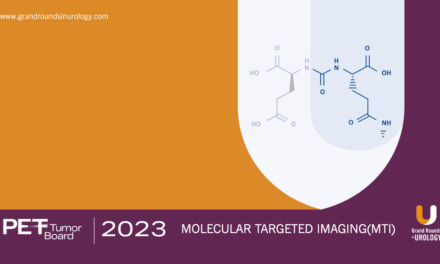Steven E. Finkelstein, MD, FACRO, presented “Radiation Oncology Perspective: Image-Guided Metastasis-Directed Therapy” during the 31st International Prostate Cancer Update in July 2021 in Snowbird, Utah.
How to cite: Finkelstein, Steven E. “Radiation Oncology Perspective: Image-Guided Metastasis-Directed Therapy.” July 2021. Accessed Apr 2024. https://grandroundsinurology.com/radiation-oncology-perspective-image-guided-metastasis-directed-therapy/
Radiation Oncology Perspective: Image-Guided Metastasis-Directed Therapy
Steven E. Finkelstein, MD, FACRO, radiation oncologist with Florida Cancer Affiliates in Panama City, Florida, discusses 3 unique cases of recurrence after robotic-assisted laparoscopic radical prostatectomy and bilateral pelvic lymphadenectomy and their clinical management from a radiation oncology perspective. He introduces the first case of a patient with a PSA of 5.4 ng/mL and a Gleason score of 5+4 at the time of initial diagnosis. Dr. Finkelstein states that the recurrence became apparent once the patient’s PSA rose from .15 to .9 and a negative bone scan led to the initially planned treatment of post-prostatectomy radiotherapy (XRT). He explains that next-generation imaging (NGI) was then ordered and showed increased tracer uptake in an area of the left pelvis, leading the patient to begin a course of intensity-modulated radiation therapy and daily image-guided radiation therapy (IGRT). Dr. Finkelstein then moves on to the second patient, who had a PSA of 4.4 ng/mL and a Gleason score of 4+4 initially and whose recurrence was identified once their post-treatment PSA rose from .25 to 1. He describes how a negative bone scan led to initially planning a post-prostatectomy XRT, but when NGI found a sclerotic lesion in the middle right iliac bone, his treatment changed to stereotactic body radiation therapy (SBRT). Dr. Finkelstein then introduces the final patient, who had a PSA of 4.4 ng/mL and a Gleason score of 4+4 and whose recurrence was identified once their post-treatment PSA of .25 increased to 1. He states that, again, a negative bone scan led to planning post-prostatectomy XRT for the patient. NGI proved that XRT would have been insufficient by identifying a sclerotic lesion in the middle right iliac bone and 5 other bone metastases. Dr. Finkelstein concludes by noting that, due to NGI, the patient also received SBRT.
About The 31st Annual International Prostate Cancer Update:
The International Prostate Cancer Update (IPCU), founded in 1990, is a multi-day CME conference focused on prostate cancer treatment updates with expert, international faculty. It is led by expert physicians and is designed for urologists, medical oncologists, radiation oncologists, and other healthcare professionals involved in the diagnosis and treatment of prostate cancer. Dr. Finkelstein delivered this educational activity during the 31st iteration of the meeting in July 2021 in Snowbird, Utah.




